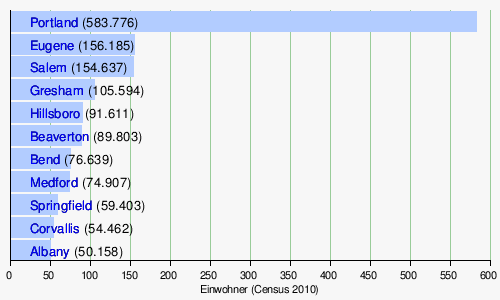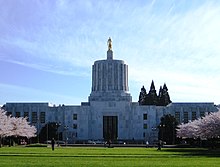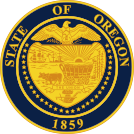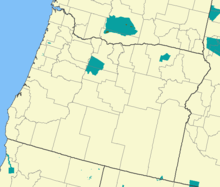Oregon
| Oregon | |||||
|---|---|---|---|---|---|
| |||||
| List of states | |||||
| Capital: | Salem | ||||
| State motto: | Alis volat propriis (lat. "She flies with her own wings") | ||||
| Surface: | 254,805 km² | ||||
| Residents: | 3,831,074 (2010 census) (15 units / km²) | ||||
| Member since: | February 14, 1859 | ||||
| Time zone: | Pacific: UTC − 8 / −7 Mountain: UTC − 7 / −6 |
||||
| The highest point: | 3425 m ( Mount Hood ) | ||||
| Average Height: | 1,005 m | ||||
| Deepest point: | 0 m ( Pacific coast ) | ||||
| Governor : | Kate Brown ( D ) | ||||
| Post / Office / ISO | OR / / US-OR | ||||
| Map of Oregon | |||||
| Oregon Geographic Map | |||||
Oregon ( English pronunciation [ ˈɔrɪɡən ] ) is a state of the United States of America . It is located in the western United States in the Pacific Northwest region and was incorporated as the 33rd state in 1859.
In terms of area, Oregon is the ninth largest state, with a population of just over 3.8 million (2010) it is only 27th among the states. Much of the population is concentrated in the Willamette Valley in the northwest of the state. There are also the three largest cities of Oregon with Portland , Eugene and the capital Salem .
Surname
The etymological origin and meaning of the choronym "Oregon" is controversial. The Columbia River was there with Indians because of the high flow rate "Ouragan" ( french hurricane , hurricane , storm ), while the Wisconsin River was called on cards "Ouaricon-sink" (it was the name of Wisconsin ). The Shoshone words for “river of the west” (“ogwa pe-on”) or “land of plenty” (“oyer-un-gon”) could also be a source. The name Oregon first appeared in 1778 when the explorer Jonathan Carver wrote of "Oregon or River of the West", possibly as a corruption of the words "Ouragan" or "Ouaricon".
Oregon is nicknamed Beaver State ( German beaver state ). Forestry, which used to dominate, has lost its strong influence; today, Oregon's economy is mainly shaped by the technology companies in the so-called Silicon Forest .
geography
With an area of 255,000 square kilometers, Oregon is the ninth largest state in the United States. This makes it a little bigger than the UK without overseas territories . The east-west extension of Oregon is 640 kilometers, while the distance from the northern to the southern border is around 580 kilometers. Approximately 98 percent of the state's territory is land.
Oregon is located in the northwestern United States (also known as the Pacific Northwest ). Oregon's neighbors are Washington in the north, Idaho in the east, and Nevada and California in the south. To the west is the Pacific Ocean . The northern boundary forms much of the Columbia River , part of the eastern boundary of the Snake River . The two mountain ranges running north-south, the Oregon Coast Range and the Cascade Range , enclose the extremely fertile Willamette Valley . The highest point is Mount Hood with a height of 3425 meters above sea level. At the same time, Oregon is one of the highest states in the United States due to the mountainous landscape that extends over almost the entire state. The average height above sea level is just over 1000 meters.
Western and northern Oregon is one of the most fertile and agriculturally productive areas on earth. In western Oregon, the amount of precipitation is very high, in the high desert in the southeastern part of Oregon , which is partly part of the Great Basin , the climate is rather arid .
climate
Oregon's climate varies significantly from region to region, particularly between the areas on the Pacific coast and the hinterland. The coastal region has a predominantly Mediterranean climate . However, Oregon lies in the temperate climate zone . Summers are hot and dry. The daytime temperatures can easily rise to over 30 ° C here. The rainfall concentrates mainly on the coast for the winter months as well as the spring and autumn. It rarely rains in summer. The winters on the Pacific are mostly mild, frost is rather rare on the coast. In the summer months the sea temperature does not rise above 12 ° C. In the mountainous hinterland, however, the climate is more extreme. Cold winters with snowfall are quite common, while the summer months in lower elevations are often hot. However, some of the highest mountains in the state are covered in snow year round .
history

Oregon was originally home to a variety of Indian tribes such as the Bannock , Chinook , Klamath, and Nez Percé . Today, nine federally recognized tribes live in Oregon.
James Cook discovered the Oregon coast in 1778 while searching for the Northwest Passage . The expedition of Lewis and Clark traveled on instructions from Thomas Jefferson through the continent to the Pacific, after the US, the former French colony of Louisiana 1803 Louisiana Purchase had bought. They also came through what would later become Oregon and pitched a winter camp at Fort Clatsop near the Columbia River. The exploration by Lewis and Clark (1805-1806) and by the British-Canadian cartographer David Thompson (1811) showed that the area was of great interest to the fur trade in North America because there were large stocks of beaver and mink . In 1811, the New York investor Johann Jakob Astor built Fort Astoria at the mouth of the Columbia River to establish a trading post for his Pacific Fur Company . In the British-American War of 1812, the Pacific Fur Company had to surrender the base to the British, but Fort Astoria became the first permanent white settlement in Oregon.
In the 1820s and 1830s the area was ruled by the British Hudson's Bay Company . John McLoughlin , the region's procurator appointed by the company, built Fort Vancouver in 1825. The Indians of the region apparently learned of the expulsion of the Indians in the east (see Path of Tears ) and were opposed to white immigration from the start .
More settlers reached Oregon from 1842 to 1843. Another war was looming between the United States and Great Britain until the disputes in the Oregon Compromise were resolved. From the American part, the Oregon Territory was formed in 1848 , which roughly included the present-day US states of Washington, Oregon, Idaho and Wyoming as well as western Montana. A few years later there was another territorial reform, after which Oregon was accepted on February 14, 1859 as the 33rd state in the union.
The authors of the Oregon State Constitution of 1857 initially left the question of slavery , which was then dividing the United States , open. They tabled three questions in a referendum: adopting the constitution, whether slavery should be allowed in Oregon, and whether free black citizens should be allowed in Oregon. Around 10,300 residents took part and adopted the constitution (≈ 70%), excluded slavery (75%) and stipulated that free blacks were not allowed to settle in Oregon (≈ 90%). The results of the vote sparked extensive debates in Washington that delayed admission as a state by around 18 months. Only in February 1859 did Congress approve the application for membership, Oregon became the 33rd state and the only one in which blacks were neither allowed as slaves nor as free. The restrictions on blacks in Oregon did not end until the 14th Amendment to the United States Constitution , after the Confederate States lost the War of Secession .
The Rogue River Wars sparked Congress when it stripped the land rights of all Indians west of the Cascade Range in 1850. After several years of fighting, they ended with the defeat and deportation of most of the Indians.
The region experienced an upswing for the first time in the 1880s, after the railroad lines greatly boosted the trade in wood and wheat . Industrial expansion began with the construction of the Bonneville Dam in 1943 to dam the Columbia River.
population
| Population development | |||
|---|---|---|---|
| Census | Residents | ± in% | |
| 1850 | 12.093 | - | |
| 1860 | 52,465 | 333.8% | |
| 1870 | 90.923 | 73.3% | |
| 1880 | 174,768 | 92.2% | |
| 1890 | 317,704 | 81.8% | |
| 1900 | 413,536 | 30.2% | |
| 1910 | 672.765 | 62.7% | |
| 1920 | 783.389 | 16.4% | |
| 1930 | 953.786 | 21.8% | |
| 1940 | 1,089,684 | 14.2% | |
| 1950 | 1,521,341 | 39.6% | |
| 1960 | 1,768,687 | 16.3% | |
| 1970 | 2,091,533 | 18.3% | |
| 1980 | 2,633,156 | 25.9% | |
| 1990 | 2,842,321 | 7.9% | |
| 2000 | 3,421,399 | 20.4% | |
| 2010 | 3,831,074 | 12% | |
| Before 1900
1900-1990 2000 |
|||
Oregon has 3,700,758 inhabitants (as of the US Census July 1, 2006), of which 86.1% are white , 10.2% Hispanic , 3.7% Asian , 1.8% Native American , 1.7% black and African American , 0.2% Hawaiians or other Pacific Islanders .
Age and gender structure
The age structure of Oregon is composed as follows:
- up to 18 years: 857,617 (23.2%)
- 18–64 years: 2,366,276 (63.9%)
- from 65 years: 476,865 (12.9%)
The median age is 37.6 years. 49.5% of the population are male and 50.5% are female.
ancestry
In 2014, 762,620 Oregon residents said they had German ancestors. With 19.2% of the total population, people of German origin are by far the strongest population group in the state. This is followed by the groups of English (11.4%), Irish (11.6%), American (5th , 5%) and people of Norwegian origin (3.8%).
Religions
The religious communities with the largest number of members in 2000 were the various groups of evangelical Protestants with 390,973 members (the strongest group are the Assemblies of God with 49,357 followers), the Roman Catholic Church with 348,239, the various other Protestant groups with 177,697 and the Church of Jesus Christ Latter-day Saints with 104,312 followers.
However, the majority of Oregon residents (2,350,112) did not belong to any of the religious communities listed above or were atheistic . According to a survey, 24.6% of the residents of Oregon do not see themselves as belonging to any religious community or describe themselves as agnostics or atheists; this is the highest of all 50 states.
Biggest cities
The largest city by far is Portland with 583,776 inhabitants ( Census 2010 ). This makes Portland the third largest city in the Pacific Northwest after Vancouver and Seattle . Also in the Willamette Valley are Eugene with 156,185 inhabitants and Salem with 154,637 inhabitants, the next two largest cities. A total of seven of Oregon's ten largest cities are located in the valley of the Willamette River and its tributaries. After Gresham, east of Portland (105,594 inhabitants in 2010), Hillsboro (91,611) and Beaverton (89,803) are the two main towns of the Silicon Forest .

politics

The governor of Oregon ruled for four years. In addition to the Oregon Senate with 30 seats, the Oregon House of Representatives has 60 seats. Oregon sends two senators and five MPs to the Senate and House of Representatives, respectively . Senators currently include Democrats Ron Wyden and Jeff Merkley ; Oregon's delegation to the 114th Congress House consists of four Democrats and Greg Walden is the only Republican . Kate Brown has been the governor of the state of Oregon since February 2015 .
Oregon is known for its moderate political culture, it is often perceived as a swing state , but has been loyal to the democratic camp in presidential elections since 1988 .
Governors
congress
Administrative division
death penalty
After the reintroduction of the death penalty, so far (as of February 2020) only two murderers have been executed (1996 and 1997) who had waived legal remedies. From 1981 to 1984 the death penalty was again banned in Oregon. In 2011, then governor John Kitzhaber imposed a moratorium. The current Governor, Kate Brown, is continuing this and signed a law in 2019 that limits the use of the death penalty to four cases:
- Acts of terrorism by organized groups in which at least 2 people are killed
- willful murder of a child under the age of 14
- Murders in prison committed by inmates already incarcerated for another murder
- willful murder of a police officer or prison guard
Since the death penalty was reintroduced through a referendum, it can only be formally abolished through a new one, but there is currently no majority.
Culture and sights
Natural monuments
More than half of the area of Oregon is federally owned. The only national park is the Crater Lake National Park in the south of the state. The central attraction is the crater lake that formed in the caldera of the Mount Mazama volcano . 468,958 visitors were counted in 2007 in the national park founded in 1902.
National Monuments in Oregon are
- Cascade-Siskiyou National Monument
- John Day Fossil Beds National Monument
- Newberry National Volcanic Monument
- Oregon Caves National Monument
Oregon also has a National Geologic Trail ( Ice Age Floods National Geologic Trail ) and eleven National Natural Landmarks (as of September 30, 2017).
The state parks in Oregon are from the Oregon Parks and Recreation Department manages. Oregon has 228 state parks with a total area of over 381 km². 170 parks are accessible to visitors with sanitary facilities, parking lots and other facilities.
Cultural monuments

The National Park Service has three National Historic Trails , two National Historical Parks, and one National Historic Site for Oregon :
- California Trail
- Lewis and Clark National Historic Trail
- Oregon Trail
- Lewis and Clark National Historical Park
- Nez Perce National Historical Park
- Fort Vancouver
There are also 17 National Historic Landmarks and 2040 buildings and sites that are registered on the National Register of Historic Places (as of September 30, 2017).
Economy and Infrastructure
The real gross domestic product per capita in 2016 was 55,411 dollars (national average of the 50 US states: 57,118; nationwide rank: 23). The unemployment rate was 4.2% in November 2017 (national average: 4.1%).
Important products are Douglas fir , grass (turf, grass seeds), Columbia River salmon, fruit and grain. On the Columbiaplateau, agriculture is restricted to artificially irrigated areas.
Until the 1980s, the test and measurement device manufacturer Tektronix was the company with the most employees. Tektronix played a pioneering role in the formation of the so-called Silicon Forest , a region in northwest Oregon and southwest Washington, in which numerous technology companies settled, especially in the 1980s and 1990s. These include the semiconductor manufacturer Intel , which operates four factories in Hillsboro with a total of 16,000 employees. Other companies with branches or factories in the Silicon Forest include Sun Microsystems , IBM , Hewlett-Packard , Xerox , Yahoo! , Mentor Graphics , Lattice Semiconductor Corporation, and Novellus Systems .
The sporting goods manufacturers Nike (in Beaverton ) and Columbia Sportswear (in Portland) are based in Oregon, Adidas has one of its main locations there (Portland). Other important industries are the timber industry, food (→ see also the article Viticulture in Oregon ) and aluminum industry as well as tourism.
Like Alaska , Delaware , Montana, and New Hampshire , Oregon does not levy sales tax .
education
The major state colleges are the University of Oregon , Oregon State University, and Portland State University . Other colleges can be found on the list of universities in Oregon .
literature
- Laura Berg: The First Oregonians , Oregon Council for the Humanities, 2007 (revised, first edition 1991).
- William G. Robbins: Oregon: This Storied Land . Oregon Historical Society Press, Portland 2005, ISBN 978-0-87595-286-4 .
- Stephen Dow Beckham: Oregon Indians. Voices from Two Centuries , Oregon State University Press, 2006.
Individual evidence
- ^ Density Using Land Area For States, Counties, Metropolitan Areas, and Places. US Census Bureau
- ^ Emily McAuliffe, Oregon Facts and Symbols (2003, 7)
- ↑ Nancy Capace, Encyclopedia of Oregon , 1999, p 2 f.
- ↑ Jonathan Carver, Travels through the interior parts of North America, 1778, p. 76
- ↑ Climate of Oregon (info text in English)
- ↑ The weather for Cannon Beach in August climate-data.org accessed on April 18, 2020
- ↑ Claude Schaeffer created a map of the tribal areas: Indian Tribes and Languages of the Old Oregon Country: A New Map. In: Oregon Historical Quarterly 60 (1959), pp. 129-133.
- ^ Notable Oregonians: John McLoughlin - Father of Oregon
- ^ Oregon State Archives: Crafting the Constitution - Oregon Ratifies the Constitution , 2009
- ^ Oregon State Archives: Crafting the Constitution - Statehood Survives the Congressional Morass , 2009
- ^ US Census Bureau - Census of Population and Housing , accessed February 28, 2011
- ↑ Excerpt from Census.gov , accessed on February 28, 2011
- ↑ Excerpt from factfinder.census.gov , accessed on February 28, 2011
- ↑ factfinder.census.gov
- ^ US Census Oregon Selected Social Characteristics
- ^ State Membership Report, Oregon. Denominational Groups, 2000. Association of Religion Data Archives
- ^ Gallup poll: Religious Identity (english) , August 7, 2009, accessed February 14, 2010
- ^ Oregon's 2010 Census Population Totals. US Census Bureau, archived from the original on December 14, 2012 ; Retrieved May 31, 2011 .
- ↑ Larry Wayne Koch, Colin Wark, John F. Galliher: The Death of the American Death Penalty: States Still Leading the Way. Northeastern University Press, Lebanon 2012, ISBN 978-1-55553-782-1 , p. 122.
- ^ National, International and Tribal. Oregon Blue Book
- ↑ Nature & Science. National Park Service
- ^ Oregon. In: nps.gov. Retrieved December 25, 2018.
- ^ Oregon. In: nps.gov. Retrieved December 25, 2018.
- ^ US Department of Commerce, BEA, Bureau of Economic Analysis: Bureau of Economic Analysis. Retrieved August 27, 2017 (American English).
- ^ Unemployment Rates for States. Retrieved January 8, 2018 .
- ↑ Elizabeth Suh: Intel's impact on community helps other businesses thrive. In: The Oregonian , October 28, 2007.
Web links
- Literature about Oregon in the catalog of the German National Library
- Oregon for the settlers . Published by the Southern Pacific Company, Portland, Oregon
- Official website of the state government
- Travel Oregon - Official state tourism website
- Oregon History Project of the Oregon Historical Society
Coordinates: 43 ° 56 ′ N , 120 ° 35 ′ W












